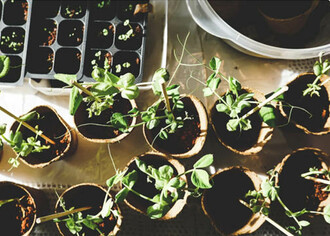
This spring, I’ve decided to try something totally new: gardening. Not just because I want pretty flowers or fresh herbs on my windowsill (although, let’s be real, those are major perks), but because I want to do something that feels grounding, intentional, and yes, sustainable.
As a first-time gardener, I’m learning that there’s a lot more to it than just putting seeds in the ground and hoping for the best. It’s about patience, observation, and conservation.
Here are a few tips I’m planning to use when I dig in, just in time for National Gardening Day.
Be Smart with Water
I’ve learned that when and how you water makes a huge difference. I’m planning to water early in the morning to minimize evaporation and avoid fungal issues that come from soggy, overnight soil. I’m also looking into using mulch and soaker hoses to keep the moisture where it belongs - down in the roots - and avoid the rookie mistake of overwatering.
Choose Native Plants
One of my top goals is to choose plants that are native to our area. From what I’ve read, they’re way easier to care for, don’t need as much water, and are great for local pollinators. Plus, they tend to be less dramatic and fussy which, let’s be honest, is perfect for someone who’s just figuring all this out.
Try Composting
Composting is high on my garden to-do list. I love the idea of turning kitchen scraps into nutrient-rich compost instead of tossing them in the garbage. It seems like a smart, natural way to feed my future plants without relying on store-bought chemicals. I’m not quite ready to start my own compost pile just yet, but I’m getting there! Until then, I’m happy to know that Aquatera uses organic waste collected at the curb for it’s innovative Landfill Gas-to-Energy Project.
Set Up a Rain Barrel
Collecting rainwater feels like such a simple and smart idea. I’m hoping to get a rain barrel set up soon to catch water from my roof and use it in the garden. It’ll save money, reduce waste, and keep my garden growing without relying entirely on tap water. Bonus: it makes me feel like I’m doing something good for the planet before I’ve even planted a single seed.
Skip the Chemicals
I’ve already decided - no pesticides! I’m going to experiment with natural solutions like neem oil and companion planting (apparently marigolds are the ultimate garden wingman). I’ve also read about attracting helpful bugs like ladybugs and lacewings. It’s exciting to think I can support a whole little ecosystem right in my own yard.
Get Creative with Containers
Before I run out and buy a bunch of new planters, I’m going to see what I already have lying around. I’m thinking about using an old crate for herbs, some mason jars for smaller plants, and maybe even a chipped teacup or two. It’s a fun way to reduce waste and add some personality to my garden before it even exists.
Think Long-Term with Perennials
Perennials are definitely part of my plan. I like the idea of planting once and enjoying the benefits year after year. I’m leaning toward low-maintenance varieties that will give me some early gardening wins and make me look like I know what I’m doing (even if I’m totally winging it).
A Garden that Grows with Me
I haven’t planted a single thing yet but I’m already seeing this garden as more than just a hobby. It’s a chance to slow down, get grounded and be one with nature, learn something new, and do a little good for the planet along the way.
This National Gardening Day, I’m not celebrating a blooming backyard (yet); I’m celebrating the intention. The plan. The excitement of starting something new. And hopefully, by this time next year, I’ll be writing about what I’ve learned from a garden that’s grown right alongside me.